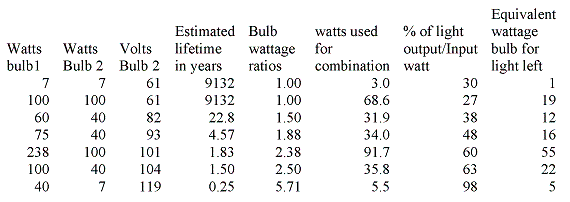
| |
 |
![]()
Efficiency of light output becomes a second priority when one is faced with the choice of light or no light for a very long period of time. If one has only this goal in mind, the answer is relatively easy. Use LEDs or Tungsten filament light bulbs at reduced voltage. The efficiency of the LED at producing light with the same input power over a given time frame is much greater than a tungsten filament by a factor of about 3 to 8 times. If you have a choice LEDs at reduced voltage are the first choice, however in a primitive environment many times there is no choice. One has to use what is at hand. Knowledge of what can be done with Tungsten filament bulbs is vital. Tungsten filament bubs should not be underestimated.The Guinness Book of World Records states that a fire station in Livermore, California has a light bulb that is said to have been burning continuously for over a century since 1901 (presumably apart from power outages). However, the bulb is powered by only 4 watts. A similar story can be told of a 40-watt bulb in Texas which has been illuminated since September 21, 1908. It once resided in an opera house where notable celebrities stopped to take in its glow, but is now in an area museum.

By lowering the service voltage, incandescent lamps can be made to last much longer than is normal (however, their brightness and efficiency goes down as well). Lifetime is defined as the length of time when half out of 100 of the same bulbs all running at the same voltage will still be burning. The other half will have burned out. When two tungsten bulbs are wired in series, assuming the same source voltage is used, the amount of light produced is reduced and the amount of power used is less than the lowest wattage bulb (see bulb 2 column in the table). In effect the larger wattage bulb is being used as a resistor for the smaller wattage bulb that then produces the majority of the light. It turns out a 60 watt tungsten light bulb wired in series with a 40 watt light bulb will last twice as long as a typical mono-color LED's 11.4 year lifetime. The LED ends up half as bright at the end of this time. The 40-60 watt series connected tungsten light starts out 38% less bright (equivalent to 12 watt bulb) with a power usage of about 32 watts. After 22.8 years it is possibly a bit brighter than it started out. This is because some of the tungsten has evaporated from the filament making it thinner. When the wattage for each bulb is close to the same, the voltage drops in half for each bulb and both will produce light for about 9,000 years. For example if two 100 watt bulbs are used, the resulting power usage is about 69 Watts. The light output is equivalent to a 19 watt bulb, as shown in the table.
Offered by Mike.